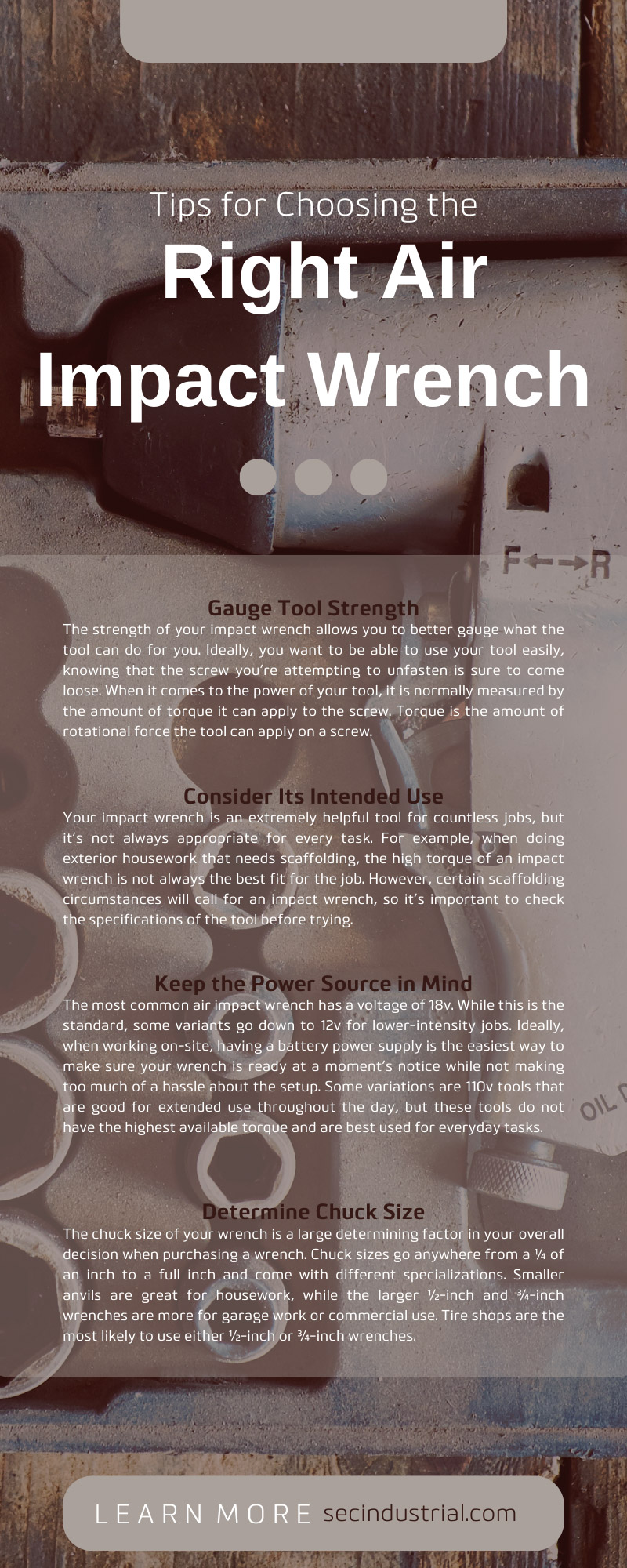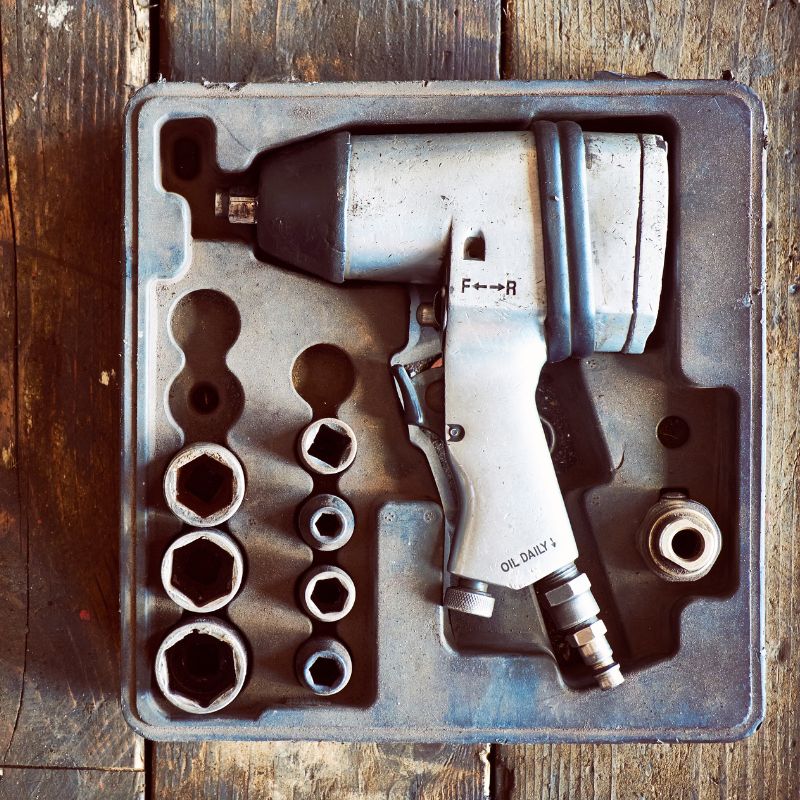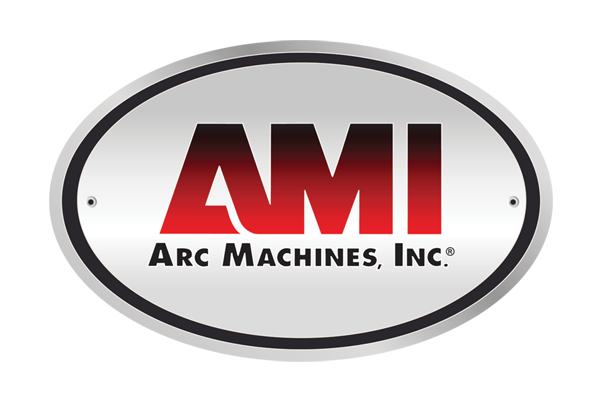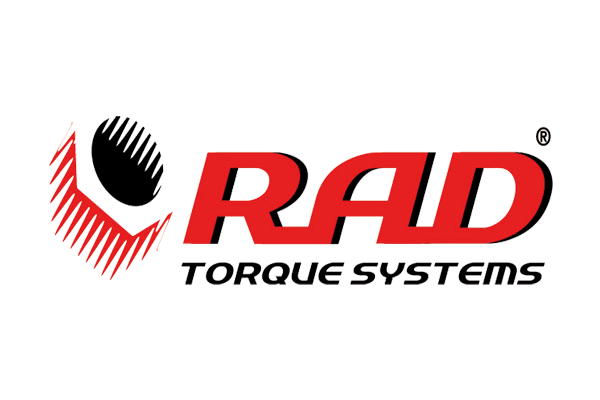5 Tips for Choosing the Right Air Impact Wrench
During certain jobs, occasionally a bolt or screw will not loosen. Sometimes it’s just a hiccup in the repair process, but an everyday tool may not be up to more complex tasks. This is typically the case with industrial machines but occasionally happens with things like car repairs as well. Whether you’re trying to make your repairs easier or you’re in the market for a higher-quality tool, it’s worth checking out these five tips for choosing the right air impact wrench for your next job.
Gauge Tool Strength
The strength of your impact wrench allows you to better gauge what the tool can do for you. Ideally, you want to be able to use your tool easily, knowing that the screw you’re attempting to unfasten is sure to come loose. When it comes to the power of your tool, it is normally measured by the amount of torque it can apply to the screw. Torque is the amount of rotational force the tool can apply on a screw. The higher the torque a tool outputs, the stronger it is overall.
Air impact wrenches have breakaway capabilities. This is when an additional surge of force is applied to a screw or bolt at the beginning of its function. While most bolts require a standard amount of torque to get free, other factors, like rust, mean that your tool needs more than its usual applied torque. This breakaway feature goes beyond the typically applied torque tools but stabilizes after the first burst.
Consider Its Intended Use
Your impact wrench is an extremely helpful tool for countless jobs, but it’s not always appropriate for every task. For example, when doing exterior housework that needs scaffolding, the high torque of an impact wrench is not always the best fit for the job. However, certain scaffolding circumstances will call for an impact wrench, so it’s important to check the specifications of the tool before trying.
The automotive industry is one of the most common uses for an air impact wrench. A car features innumerable tight bolts that are not easy to remove with hand tools or by force. A high-torque power tool, however, can undo any bolt on a car’s tires. Air impact wrenches are also great for tightening bolts when you need to put things back together or strengthen existing attachments.
Keep the Power Source in Mind
The most common air impact wrench has a voltage of 18v. While this is the standard, some variants go down to 12v for lower-intensity jobs. Ideally, when working on-site, having a battery power supply is the easiest way to make sure your wrench is ready at a moment’s notice while not making too much of a hassle about the setup. Some variations are 110v tools that are good for extended use throughout the day, but these tools do not have the highest available torque and are best used for everyday tasks.
Inside the wrench is an electric torque multiplier that gives the user an advantage while using the tool; this internal part offers greater precision, safety, and efficiency when using the device. It’s important to keep in mind that this part is only as reliable as the power source you are using. Power sources are mostly up to preference. So long as it gets the same job done, the final decision is up to you. Whether you want to worry about having enough time in the day to keep working with your remaining power or continually looking for a socket is up to you. Regardless, having an air impact wrench around is a necessity when the need for it arises.
Evaluate Cordless vs. Pneumatic
The next facet to consider is whether you want your wrench to be cordless or pneumatic. Cordless impact wrenches have several benefits in terms of their overall maneuverability and worry-free setup. Walking around a job site and being confidently prepared to deal with hard-to-loosen bolts makes your life a lot easier. However, there are also great benefits to pneumatic tools.
Pneumatic impact wrenches use an air compressor that disperses air through the wrench to give it power. This allows you to have a reliable energy source without worrying that it will run out. Not having to charge any batteries beforehand is helpful, as is the added benefit of having a lightweight build and improved safety. Batteries often add extra weight to your tool, and when drawn out throughout the day, they add strain to your wrists. Depending on how much you prioritize comfort, pneumatic tools may be the right choice.
Determine Chuck Size
The chuck size of your wrench is a large determining factor in your overall decision when purchasing a wrench. Chuck sizes go anywhere from a ¼ of an inch to a full inch and come with different specializations. Smaller anvils are great for housework, while the larger ½-inch and ¾-inch wrenches are more for garage work or commercial use. Tire shops are the most likely to use either ½-inch or ¾-inch wrenches. The largest variants are normally reserved for industrial work that typically takes place in manufacturing facilities, power plants, or mines.
While the chuck size seems like a small factor, it defines the kinds of jobs you plan to do and categorizes its capabilities for you. Choosing the right one for your intended job is crucial to ensuring you are not left scratching your head. The last thing you need is to try applying your tool to a bolt only to realize it either isn’t strong enough to handle it or isn’t a good enough match for the bolt you’re dealing with.
From the chuck size to the electric torque multiplier, there are several factors to consider when deciding on the right impact wrench for you. This tool is essential to the kit for those who are actively on different job sites or constantly doing hands-on work. Being prepared to tackle any job you set your sights on is important when being a flexible worker. These five tips for choosing the right air impact wrench are a good place to start to help you prepare for the next big project.










